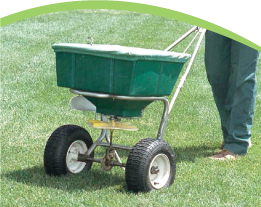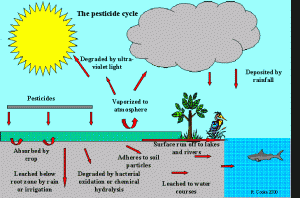EPA has developed a number of short, informative videos to help you go green with your lawncare practices
>Smart Irrigation
An American family of four can use 400 gallons of water per day, and about 30 percent of that is devoted to outdoor uses. More than half of that outdoor water is used for watering lawns and gardens. Nationwide, landscape irrigation is estimated to account for almost one-third of all residential water use, totaling more than 7 billions gallons per day.
Some experts estimate that up to 50 percent of water used for irrigation is wasted due to evaporation, wind or runoff caused by overwatering.
For a healthy, drought-and stress-tolerant lawn and landscape, use less water. Adopting water-savvy habits also is essential to maintaining and extending your community's water supply, especially during peak use. Water-efficient habits will result in a healhier lawn and landscape, in addition to conserving water and saving money. With some simple practices and new technology, existing irrigation systems can be made more efficient - lowering your water bill, reducing run off and eliminating waste.
11 Steps to Become a Smart Irrigator:
- Reduce demand - use native plants in your landscape. They require less care and water than ornamental varieties. And apply mulch around shrubs and garden plants to reduce evaporation.
- Less is more - if you step on your lawn and the grass springs back, it does not need to be watered. Watering plants too much and too frequently results in shallow roots, weed growth, disease and fungus.
- Seasons change, so should your system - familiarize yourself with the settings on your irrigation controller and adjust the watering schedule regularly to conform with seasonal weather conditions.
- Play "zone" defense - schedule each individual zone in your irrigation system to account for the type of sprinkler, sun or shade exposure, and the soil type for the specific area. The same watering schedule rarely applies to all zones in the system.
- Make it a date - Inspect your irrigation system monthly. Check for leaks, broken or clogged heads, and other problems, or engage an irrigation professional to regularly check your system. Clean micro-irrigation filters as needed.
- Get your head adjusted - Correct obstructions in sprinkler heads that prevent sprinklers from distributing water evenly. Keep water off pavement and structures.
- Check for WaterSense - A certified irrigation professional can design, install, maintain or audit your system to ensure optimal efficiency using the proper amount of water to maintain a healthy landscape. Ask if your irrigation contractor is a WaterSense partner, which means he or she has been certified through a program that focuses on water efficiency.
- Get smart - climate or soil moisture sensor-based "smart" controllers evaluate weather or soil moisture conditions, then calculate and automatically adjust the irrigation schedule to meet the specfic needs of your landscape.
- Flip to a swith - rain shutoff switches, required by law in many states, turn off your system in rainy weather and help compensate for natural rainfall. This inexpensive device can be retrofitted to almost any system.
- Easy does it - install low-volume micro-irrigation for gardens, trees, and shrubs. Micro-irrigation includes drip, micro-spray jets, micro-sprinklers, or bubbler irrigation to irrigate slowly and minimize evaporation, runoff and overspray.
- Watch the clock - Water when the sun is low or down, winds are calm, and temperatures are cool - between the evening and early morning - to reduce evaporation. You can lose as much as 30 percent of water to evaporation by watering midday.
Watering Can Be Efficient (hyperlink to EPA WaterSense brochure) - learn how to fine tune your irrigation system to save water and money
Checklist for a Water-Efficient Irrigation System (hyperlink to EPA WaterSense checklist)
Landscape Irrigation Controllers (hyperlink to EPA WaterSense document)
Fertlizers

To protect our water, reduce fertilizer use, fertilize properly, and apply at the right time.
Suffolk County Law 41-2007
Fertilizer applications to lawns between November 1st and April 1st are prohibited. This law was passed to reduce nitrogen pollution in our groundwater and surface waters caused by improper lawn fertilization.
Violators may be fined up to $1,000.
Clean Water Websites
http://healthylawns.suffolkcountyny.gov/
EPA Healthy Lawn Care Practices: Fertilizing
Pesticides and Herbicides

Over 10 million pounds of pesticides are applied on Long Island every year, presenting a serious threat of contamination to our groundwater which serves as our sole source for drinking water. Insects, weeds and fungal diseases in a lawn are often symptoms of underlying problems. Conventional methods that address the symptoms with chemicals that can be harmful to human health and the environment are simply not sustainable.
Do-It-Yourself Organic Lawncare (hyperlink to Sustainability Institute brochure)